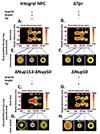Unraveling docking and initiation of mRNA export through the nuclear pore complex
- PMID: 35754154
- PMCID: PMC9308666
- DOI: 10.1002/bies.202200027
Unraveling docking and initiation of mRNA export through the nuclear pore complex
Abstract
The nuclear export of mRNA through the nuclear pore complex (NPC) is a process required for the healthy functioning of human cells, making it a critical area of research. However, the geometries of mRNA and the NPC are well below the diffraction limit of light microscopy, thereby presenting significant challenges in evaluating the discrete interactions and dynamics involved in mRNA nuclear export through the native NPC. Recent advances in biotechnology and single-molecule super-resolution light microscopy have enabled researchers to gain granular insight into the specific contributions made by discrete nucleoporins in the nuclear basket of the NPC to the export of mRNA. Specifically, by expanding upon the docking step facilitated by the protein TPR in the nuclear basket as well as identifying NUP153 as being the primary nuclear basket protein initiating export through the central channel of the NPC.
© 2022 Wiley Periodicals LLC.
Conflict of interest statement
Conflict of Interest
The authors state there is no conflict of interest.
Figures




Similar articles
-
Distinct roles of nuclear basket proteins in directing the passage of mRNA through the nuclear pore.Proc Natl Acad Sci U S A. 2021 Sep 14;118(37):e2015621118. doi: 10.1073/pnas.2015621118. Proc Natl Acad Sci U S A. 2021. PMID: 34504007 Free PMC article.
-
The human TREX-2 complex is stably associated with the nuclear pore basket.J Cell Sci. 2013 Jun 15;126(Pt 12):2656-67. doi: 10.1242/jcs.118000. Epub 2013 Apr 16. J Cell Sci. 2013. PMID: 23591820
-
Spelling out the roles of individual nucleoporins in nuclear export of mRNA.Nucleus. 2022 Dec;13(1):170-193. doi: 10.1080/19491034.2022.2076965. Nucleus. 2022. PMID: 35593254 Free PMC article. Review.
-
Localization of nucleoporin Tpr to the nuclear pore complex is essential for Tpr mediated regulation of the export of unspliced RNA.PLoS One. 2012;7(1):e29921. doi: 10.1371/journal.pone.0029921. Epub 2012 Jan 13. PLoS One. 2012. PMID: 22253824 Free PMC article.
-
Into the basket and beyond: the journey of mRNA through the nuclear pore complex.Biochem J. 2020 Jan 17;477(1):23-44. doi: 10.1042/BCJ20190132. Biochem J. 2020. PMID: 31913454 Review.
Cited by
-
Structural mechanism of DDX39B regulation by human TREX-2 and a related complex in mRNP remodeling.Nat Commun. 2025 Jul 1;16(1):5471. doi: 10.1038/s41467-025-60547-1. Nat Commun. 2025. PMID: 40595470 Free PMC article.
-
Deciphering vesicle-assisted transport mechanisms in cytoplasm to cilium trafficking.Front Cell Neurosci. 2024 May 27;18:1379976. doi: 10.3389/fncel.2024.1379976. eCollection 2024. Front Cell Neurosci. 2024. PMID: 38860265 Free PMC article. Review.
-
O-GlcNAc modulation of nuclear pore complexes orchestrates mRNA export efficiency.Proc Natl Acad Sci U S A. 2025 Aug 12;122(32):e2502687122. doi: 10.1073/pnas.2502687122. Epub 2025 Aug 7. Proc Natl Acad Sci U S A. 2025. PMID: 40773237 Free PMC article.
References
-
- Alber F, Dokudovskaya S, Veenhoff LM, Zhang W, Kipper J, Devos D, … Chait BT (2007). The molecular architecture of the nuclear pore complex. Nature, 450(7170), 695–701. - PubMed
Publication types
MeSH terms
Substances
Grants and funding
LinkOut - more resources
Full Text Sources

